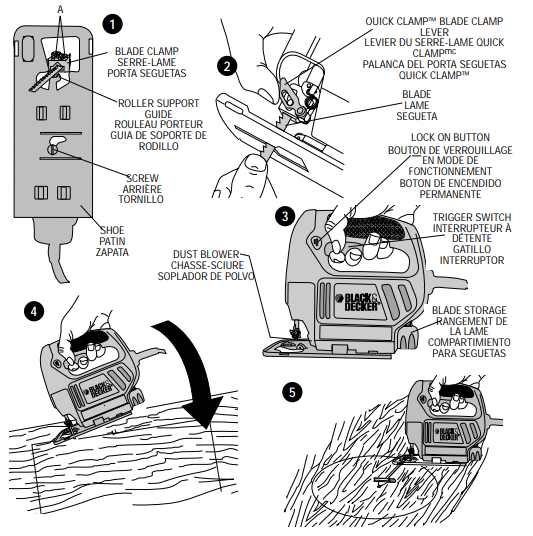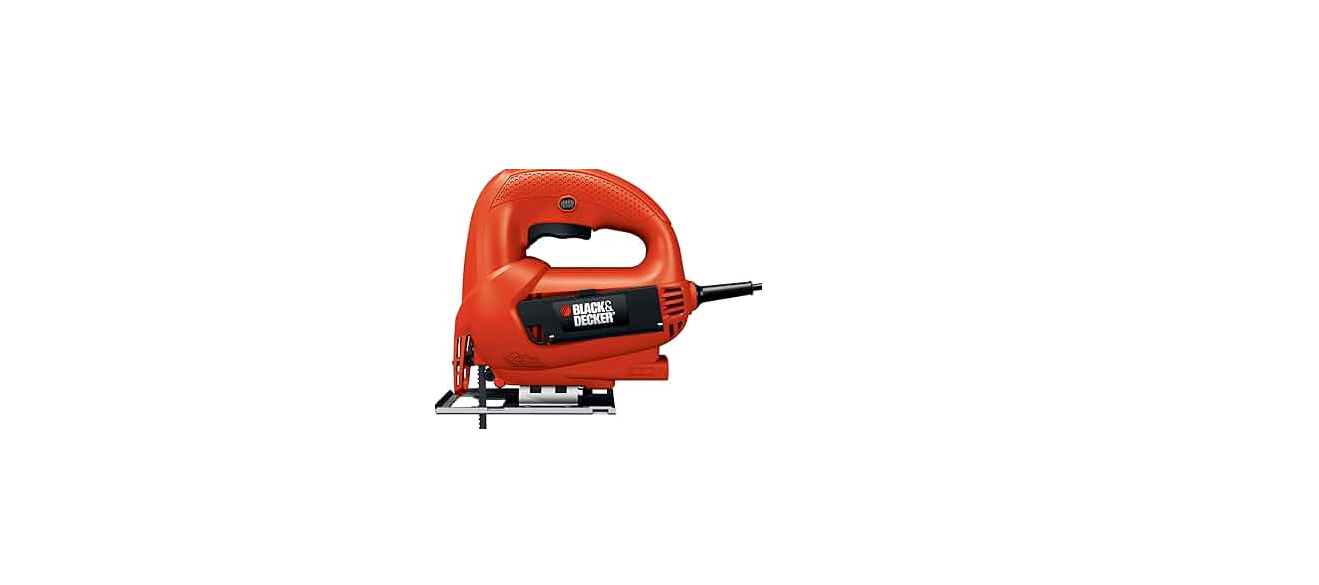Black & Decker 7552 Single and Variable Speed Jig Saws Guide

SAVE THESE INSTRUCTIONS
WORK AREA
- Keep your work area clean and well-lit. Cluttered benches and dark areas invite accidents.
- Do not operate power tools in explosive atmospheres, such as in the presence of flammable liquids, gases, or dust. Power tools create sparks that may ignite the dust or fumes.
- Keep bystanders, children, and visitors away while operating a power tool. Distractions can cause you to lose control.
ELECTRICAL SAFETY
- Double-insulated tools are equipped with a polarized plug (one blade is wider than the other.) This plug will fit in a polarized outlet only one way. If the plug does not fit fully in the outlet, reverse the plug. If it still does not fit, contact a qualified electrician to install a polarized outlet. Do not change the plug in any way. Double insulation eliminates the need for the three-wire grounded power cord and grounded power supply system.
- Avoid body contact with grounded surfaces such as pipes, radiators, ranges, and refrigerators. There is an increased risk of electric shock if your body is grounded.
- Don’t expose power tools to rain or wet conditions. Water entering a power tool will increase the risk of electric shock.
- Do not abuse the cord. Never use the cord to carry the tools or pull the plug from an outlet. Keep the cord away from heat, oil, sharp edges, or moving parts. Replace damaged cords immediately. Damaged cords increase the risk of electric shock.
- When operating a power tool outside, use an outdoor extension cord marked “W-A” or “W”. These cords are rated for outdoor use and reduce the risk of electric shock.
PERSONAL SAFETY
- Stay alert, watch what you are doing, and use common sense when operating a power tool. Do not use tools while tired or under the influence of drugs, alcohol, or medication. A moment of inattention while operating power tools may result in serious personal injury.
- Dress properly. Do not wear loose clothing or jewelry. Contains long hair. Keep your hair, clothing, and gloves away from moving parts. Loose clothing, jewelry, or long hair can be caught in moving parts. Air vents cover moving parts and should be avoided.
- Avoid accidental starting. Be sure the switch is off before plugging in. Carrying tools with your finger on the switch or plugging in tools that have the switch on invites accidents.
- Remove adjusting keys or wrenches before turning the tool on. A wrench or key that is left attached to a rotating part of the tool may result in personal injury
- Do not overreach. Keep proper footing and balance at all times. Proper footing and balance enable better control of the tool in unexpected situations.
- Use safety equipment. Always wear eye protection. Dust masks, non-skid safety shoes, hard hats, or hearing protection must be used for appropriate conditions.
TOOL USE AND CARE
- Use clamps or other practical ways to secure and support the workpiece to a stable platform. Holding the work by hand or against your body is unstable and may lead to loss of control.
- Do not force tools. Use the correct tool for your application. The correct tool will do the job better and safer at the rate for which it is designed.
- Do not use the tool if the switch does not turn it on or off. Any tool that cannot be controlled with the switch is dangerous and must be repaired.
- Disconnect the plug from the power source before making any adjustments, changing accessories, or storing the tool. Such preventative safety measures reduce the risk of starting the tool accidentally.
- Store idle tools out of reach of children and other untrained persons. Tools are dangerous in the hands of untrained users.
- Maintain tools with care. Keep cutting tools sharp and clean. Properly maintained tools, with sharp cutting edges are less likely to bind and are easier to control.
- Check for misalignment or binding of moving parts, breakage of parts, and any other condition that may affect the operation of the tool. If damaged, have the tool serviced before using. Many accidents are caused by poorly maintained tools.
- Use only accessories that are recommended by the manufacturer for your model. Accessories that may be suitable for one tool, may become hazardous when used on another tool.
SERVICE
- Tool service must be performed only by qualified repair personnel. Service or maintenance performed by unqualified personnel could result in a risk of injury.
- When servicing a tool, use only identical replacement parts. Follow instructions in the Maintenance section of this manual. Use of unauthorized parts or failure to follow Maintenance Instructions may create a risk of electric shock or injury.

EXTENSION CORDS
When using an extension cord, be sure to use one heavy enough to carry the current your product will draw. An undersized cord will cause a drop in line voltage resulting in loss of power and overheating. The following table shows the correct size to use depending on cord length and nameplate ampere rating. If in doubt, use the next heavier gauge. The smaller the gauge number, the heavier the cord.

MOTOR
Be sure your power supply agrees with nameplate marking. 120 Volts AC only means your tool will operate on standard 60 Hz household power. Do not operate AC tools on DC. A rating of 120 volts AC/DC means that your tool will operate on standard 60 Hz AC or DC power. This information is printed on the nameplate. Lower voltage will cause loss of power and can result in overheating. All Black & Decker tools are factory-tested; if this tool does not operate, check the power supply.
ASSEMBLY/ADJUSTMENT SET-UP
BEFORE INSTALLING THE BLADES, TURN OFF AND UNPLUG TOOL.
Loosen (do not remove) the two screws “A” in Figure 1. Ensure the blade teeth are facing forward and insert the saw blade shank fully into the blade clamp. Slightly tighten the screws alternately to position the blade, then fully tighten the screws. To release, turn both screws one turn counterclockwise.
BEFORE INSTALLING THE BLADES, TURN OFF AND UNPLUG THE TOOL.
Your jig saw uses the Quick Clamp™ blade changing system. To install a blade, lift the Quick Clamp™ lever (Figure 2). Ensure the blade teeth are facing forward and insert the saw blade shank fully into the blade clamp. Release the lever and the blade will be clamped securely in place. To release the blade, lift the lever.
ROLLER SUPPORT GUIDE
The roller support guide on your jig saw improves its performance when cutting tough materials by adding support to the blade. This support should be adjusted so that the roller touches the back of the blade when cutting. Ensure the blade is aligned with the groove in the roller. Adjust the support roller by loosening the screw on the bottom of the shoe (Fig.1) and moving the shoe so that the roller touches the back edge of the blade. Retighten screw. Lubricating the guide roller from time to time with a drop of oil will extend the life of the roller.
BEFORE PLUGGING YOUR JIG SAW IN, ENSURE THAT THE TRIGGER SWITCH IS IN THE OFF POSITION.
To turn the saw on, squeeze the trigger switch, as shown in Figure 3. To turn the tool off, release the trigger switch. The tool can be locked on for continuous operation by fully squeezing and holding the trigger switch while you depress the lock-on button shown in Fig. 3. With the lock-on button depressed, release the trigger switch and the tool will continue to run. To release from the lock position, squeeze and release the trigger. Always disengage the lock before disconnecting from the power supply.
VARIABLE SPEED SWITCH
BEFORE PLUGGING YOUR JIG SAW IN, ENSURE THAT THE TRIGGER SWITCH IS IN THE OFF POSITION.
To turn the saw on, squeeze the trigger switch, as shown in Figure 3. The speed of the saw is determined by how much the trigger switch is depressed. To turn the tool off, release the trigger switch. The tool can be locked on for continuous operation by fully squeezing and holding the trigger switch while you depress the lock-on button shown in Fig. 3. With the lock-on button depressed, release the trigger switch and the tool will continue to run. To release from the lock position, squeeze and release the trigger. Always disengage the lock before disconnecting from the power supply. Do not overload your jig saw as this could damage the motor. Use your saw only for its intended purpose.
BEVEL ADJUSTMENT
TURN OFF AND UNPLUG TOOL. To adjust the bevel angle, loosen the screw (approximately 3 full turns) on the bottom of the shoe, as shown in Figure 1. Lift the shoe slightly and pull backward, then set the shoe at 45° and retighten the screw. To reset the shoe for a square cut, loosen the screw and move the shoe until it is approximately 90° to the blade. Adjust the blade support roller to the blade and retighten the screw.
GENERAL CUTTING
Be sure the board is firmly secured. Hold the jig saw by the handle and operate the switch to turn the unit on. Don’t attempt to turn on the unit when the blade is against the material to be cut. This could stall the motor. Place the front of the shoe on the material to be cut and hold the jig saw shoe down firmly against the work surface while cutting. Don’t force the tool; let the blade cut at its own speed. Whenever possible, clamp or support work close to the line of cut; when the cut is completed, shut off power and lay the saw aside before loosening the work.
METAL & PLASTIC CUTTING
In cutting thin gauge sheet metals, it is best to clamp wood or plywood to the bottom of the metal sheet; this will ensure a clean cut without the danger of vibration or tearing of metal. Use a fine-tooth blade for ferrous metals (for those that have an iron content), and use a coarser blade for nonferrous metals (those that do not have an iron content).
Cutting thin metal will take longer than cutting relatively thick wood so do not be tempted to speed up the process by forcing the saw. Spread a thin film of cutting lubricant along the cutting line (any lightweight oil). Use low speeds for cutting metals, plastics, and composition tiles. When cutting laminated plastic, place the finished side down and use a fine tooth hollow ground blade.
POCKET CUTTING
- Measure the surface to be cut and mark clearly with a pencil. Next tip the saw forward until the front edge of the shoe sits firmly on the work surface, but with the blade well clear of it Figure 4.
- Turn the tool on and allow it to attain maximum speed by fully depressing the trigger switch.
- Grip the handle firmly and slowly lower the back edge of the tool until the blade cuts smoothly into the material. Do not move the jig saw forward along the cut line until the saw blade has completely entered the material and the shoe comes to rest flat on its surface.
RIP & CIRCLE CUTTING
Ripping and circle cutting without a pencil line are easily done with the rip fence and circle guide (available at extra cost). Using the screw supplied with the accessory guide, position as shown in Figure 5 and thread the screw into the shoe to clamp the fence securely. When circle cutting, adjust rip fence so that distance from blade to hole in cross bar is at the desired radius and tighten screw (use hole which lines up best with saw blade).
Place the saw so that the hole in the crossbar is over the center of the circle to be cut (make the pocket cut, drill a hole for the blade, or cut inward from the edge of the material to get the blade into position). When saw is properly positioned, drive a small nail through hole in cross bar. Using the rip fence as a pivot arm, begin cutting a circle. For circle cutting, the cross bar should be up, as shown in Figure 5. When ripping, slide the rip fence under the screw from either side of the saw. Set the crossbar at the desired distance from blade and tighten screw. For ripping, the cross bar should be down and against the straight edge of the workpiece.
MAINTENANCE
Use only mild soap and a damp cloth to clean the tool. Never let any liquid get inside the tool; never immerse any part of the tool into a liquid. IMPORTANT: To assure product SAFETY and RELIABILITY, repairs, maintenance and adjustment should be performed by authorized service centers or other qualified service organizations, always using identical replacement parts.
SERVICE INFORMATION
Black & Decker offers a full network of company-owned and authorized service locations throughout North America. All Black & Decker Service Centers are staffed with trained personnel to provide customers with efficient and reliable power tool service. Whether you need technical advice, repair, or genuine factory replacement parts, contact the Black & Decker location nearest you. To find your local service location, refer to the yellow page directory under “Tools—Electric” or call: 1-800-544-6986.
FULL FIVE-YEAR HOME USE WARRANTY
Black & Decker (U.S.) Inc. warrants this product for five years against any defects in material or workmanship. The defective product will be replaced or repaired at no charge in either of two ways. The first, which will result in exchanges only, is to return the product to the retailer from whom it was purchased (provided that the store is a participating retailer). Returns should be made within the time period of the retailer’s policy for exchanges (usually 30 to 90 days after the sale).
Proof of purchase may be required. Please check with the retailer for their specific return policy regarding returns that are beyond the time set for exchanges. The second option is to take or send the product (prepaid) to a Black & Decker-owned or authorized Service Center for repair or replacement at our option. Proof of purchase may be required.
Black & Decker-owned and authorized Service Centers are listed under “Tools-Electric” in the Yellow Pages of the phone directory. This warranty does not apply to accessories. This warranty gives you specific legal rights and you may have other rights which vary from state to state. Should you have any questions, contact the manager of your nearest Black & Decker Service Center.
NOTE:
This too is designed, manufactured, and tested to meet or exceed the needs of the do-it-yourselfer in the execution of projects and repairs in and around the home. With proper use, it will provide the homeowner with years of service. However, if you use tools for a living and use this product or any of Black & Decker’s other Consumer Home Use tools ON THE JOBSlTE you should know that they CANNOT BE COVERED UNDER OUR WARRANTY.
REFERENCE LINK
https://www.ereplacementparts.com/black-and-decker-7552-type-jigsaw-parts-c-4167_4262_4278.html





